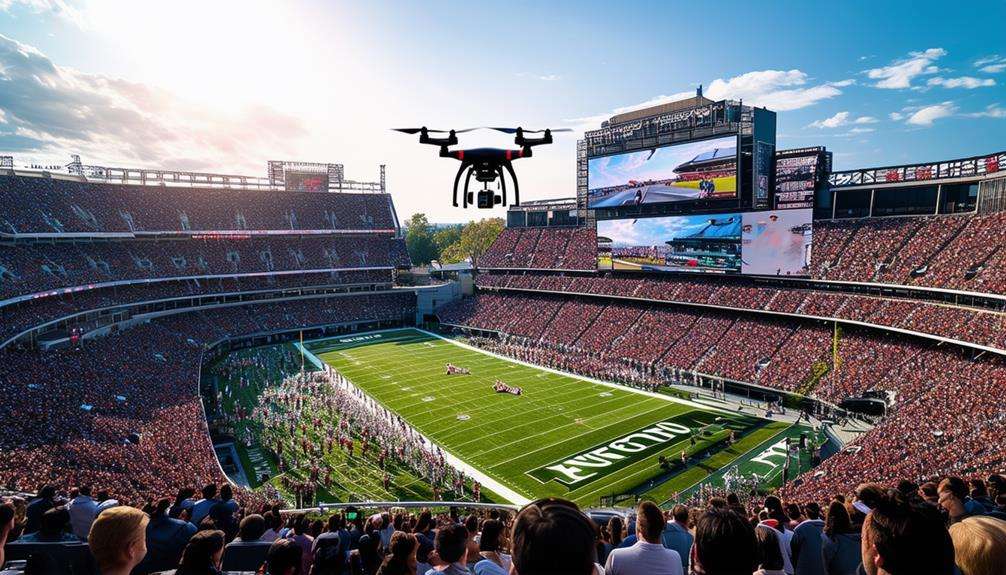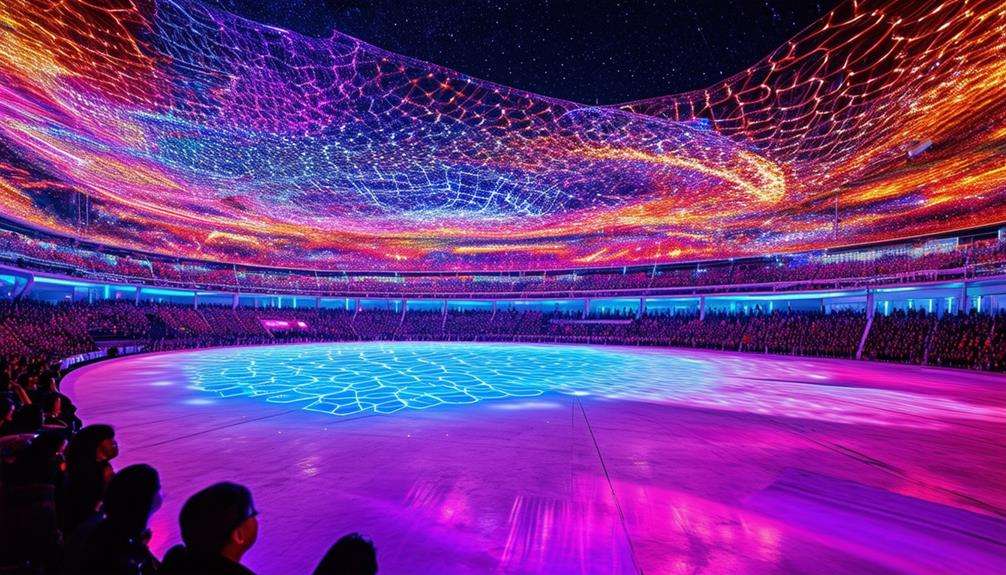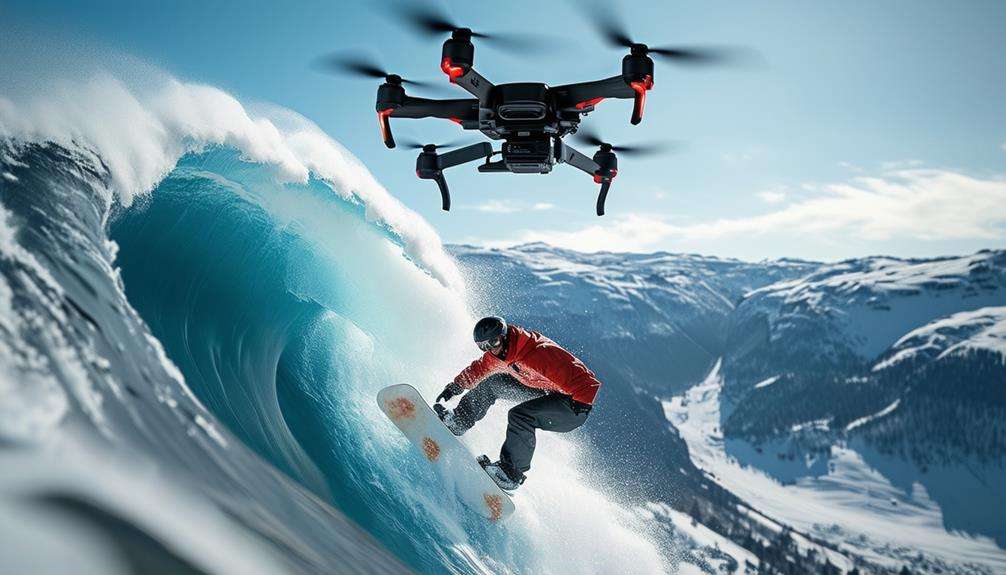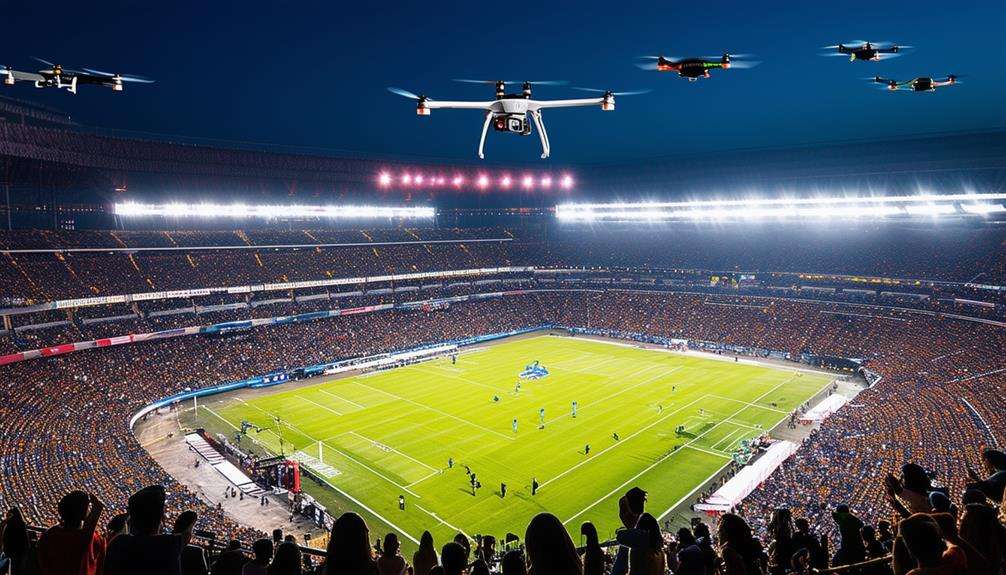The Rise of Drone Racing as a Competitive Sport
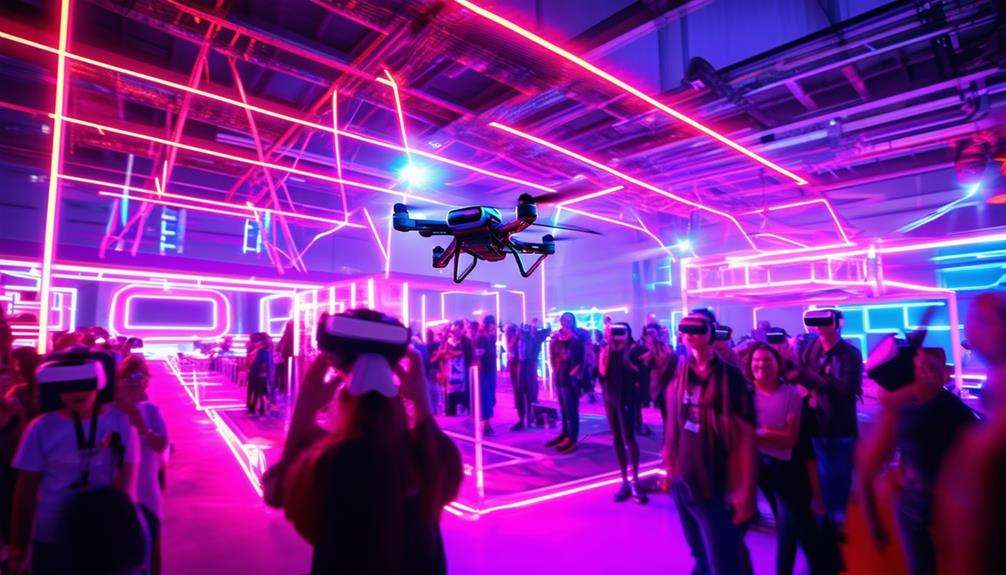
Imagine piloting a high-speed drone through a complex, neon-lit course, competing against the world's best pilots. Drone racing has rapidly evolved from informal gatherings to organized events with significant global followings.
This niche hobby has transformed into a mainstream sport, with leagues like the Drone Racing League setting the standard. What skills and technology are driving this surge in popularity? As you delve into the rise of drone racing, you'll uncover the elements that make it a cutting-edge and fiercely competitive arena.
Understanding Drone Racing
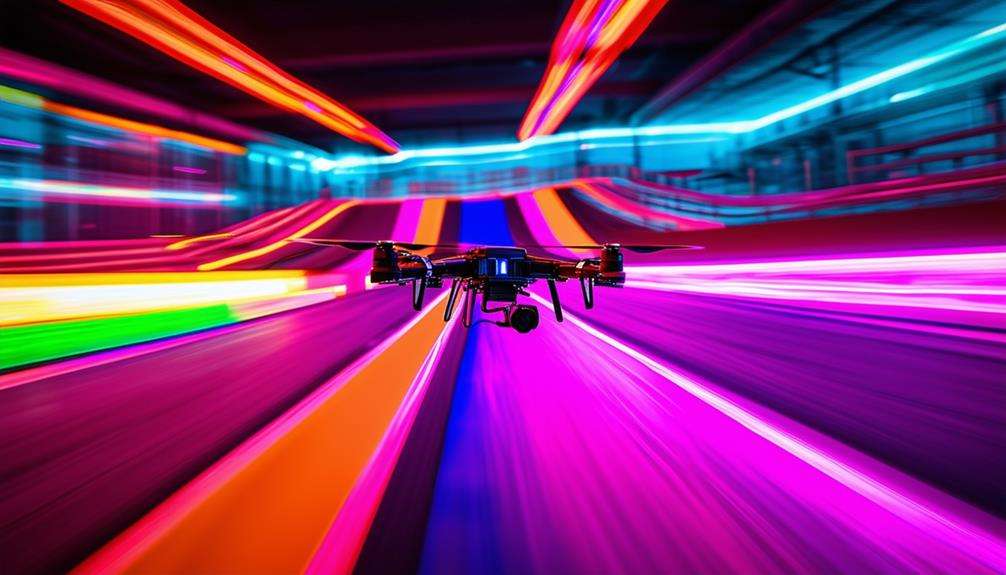
Drone racing is a high-octane sport where pilots navigate fast drones through complex courses using FPV (first-person view) goggles. This technology offers real-time visuals from the drone's perspective, making the experience immersive and allowing for precise control. Competitive racing demands not just speed but also extraordinary agility, as pilots maneuver through intricate obstacle courses, showcasing their precision flying skills.
FPV technology has revolutionized drone racing by enhancing navigation capabilities and providing an edge in competition. The sport is continually evolving with drones becoming faster, more agile, and more responsive. Staying updated with the latest technological advancements is crucial for maintaining a competitive edge.
The combination of skill, cutting-edge technology, and adrenaline makes drone racing captivating for both pilots and spectators. Each race is a unique blend of strategy and speed, pushing the limits of what drones can achieve.
Origins of Drone Racing
As the captivating world of drone racing continues to attract enthusiasts, it's intriguing to delve into its humble beginnings in 2011 in Karlsruhe, Germany. At that time, a small group of tech aficionados gathered to test their piloting skills in an innovative and exhilarating manner. These informal meetups quickly evolved into a more structured and competitive pursuit.
Drone racing's appeal lies in its unique combination of technology and athleticism. Early events featured high-speed races through complex courses, demanding pilots to navigate with precision and agility. The sport's growth was swift, with multiple leagues forming globally, hosting events with cash prizes and sponsorship deals. This marked the beginning of drone racing's recognition as a legitimate competitive sport.
The establishment of professional leagues like the Drone Racing League (DRL) significantly contributed to the sport's expansion. These organizations have been crucial in attracting a growing audience of enthusiasts and professional racers. With organized events that highlight the skills of top pilots, drone racing has continued to gain global traction and recognition. The sport's journey from its modest origins in Germany to an international competitive arena underscores its engaging and dynamic nature.
Evolution of Drone Technology
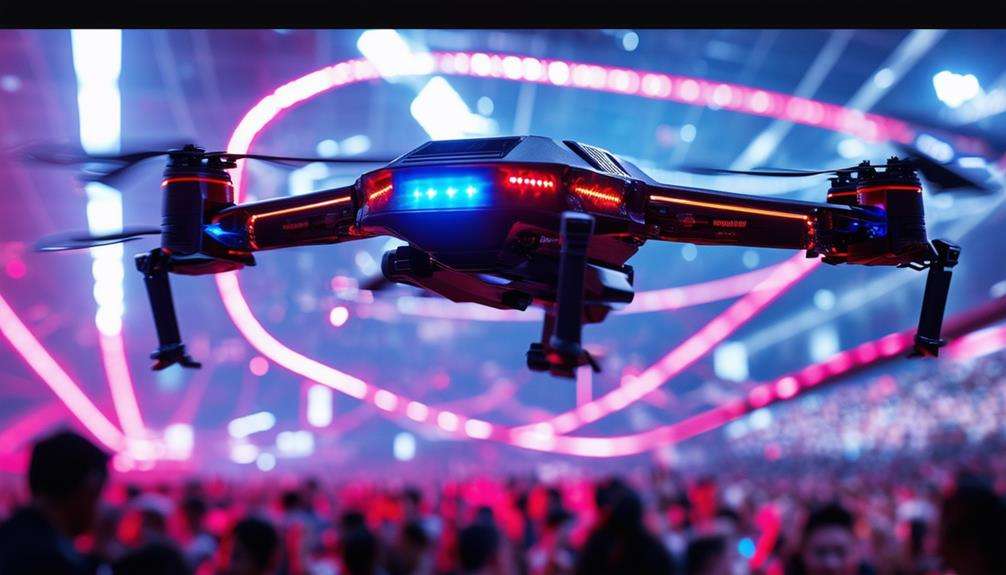
In recent years, advancements in drone technology have dramatically transformed the landscape of competitive drone racing. Modern racing drones are now faster, more agile, and incredibly responsive, reaching speeds of up to 120mph. This evolution is the result of continuous innovation by manufacturers striving to meet the high demands of this thrilling sport.
FPV (First Person View) goggles play a crucial role in this transformation. With FPV goggles, pilots experience a real-time, immersive view from the drone, allowing for precise steering and an adrenaline-filled experience. Flight controllers have also seen significant improvements, offering smooth and accurate control essential for navigating complex courses.
Key developments include:
- Speed Enhancements: Racing drones now achieve incredible speeds, pushing the boundaries of human reflexes.
- Agility Improvements: Advanced designs enable sharper turns and quicker responses, crucial for tight racing circuits.
- FPV Technology: Modern FPV goggles provide real-time video feeds, enhancing the immersive experience.
- Flight Controllers: Improved controllers offer better stability and control, critical for high-speed races.
- Durability: Innovative materials and construction methods ensure racing drones can withstand crashes and collisions.
The evolution of drone technology hasn't only enhanced performance but also significantly contributed to the sport's growing popularity.
Popular Drone Racing Events
Experience the adrenaline rush of drone racing by tuning into premier events like the Drone Racing League (DRL), the World Drone Prix, and the FAI World Drone Racing Championship. The DRL stands out, featuring drones that reach speeds up to 80 mph. This spectacle is broadcasted on 13 sports networks across six continents, connecting with over 250 million households worldwide. The pilots' skill and the dizzying speed of the drones are sure to captivate you.
Another major event is the World Drone Prix in Dubai, where top pilots from around the globe compete for a substantial prize pool. This race is a true test of skill and precision, attracting both seasoned professionals and enthusiastic spectators.
For those interested in more structured and competitive formats, the FAI World Drone Racing Championship offers national teams the chance to vie for the title of world champion. If you're looking to get involved at the grassroots level, the MultiGP Drone Racing League is perfect for local and regional events. These professional leagues showcase the best use of FPV (First-Person View) goggles, giving pilots an immersive experience as they navigate the courses.
| Event | Unique Feature |
|---|---|
| Drone Racing League (DRL) | Drones reaching speeds up to 80 mph |
| World Drone Prix | Substantial prize pool |
| FAI World Drone Championship | National teams competing for title |
These events not only provide thrilling entertainment but also highlight the evolving technology and skill involved in drone racing.
Key Players and Teams
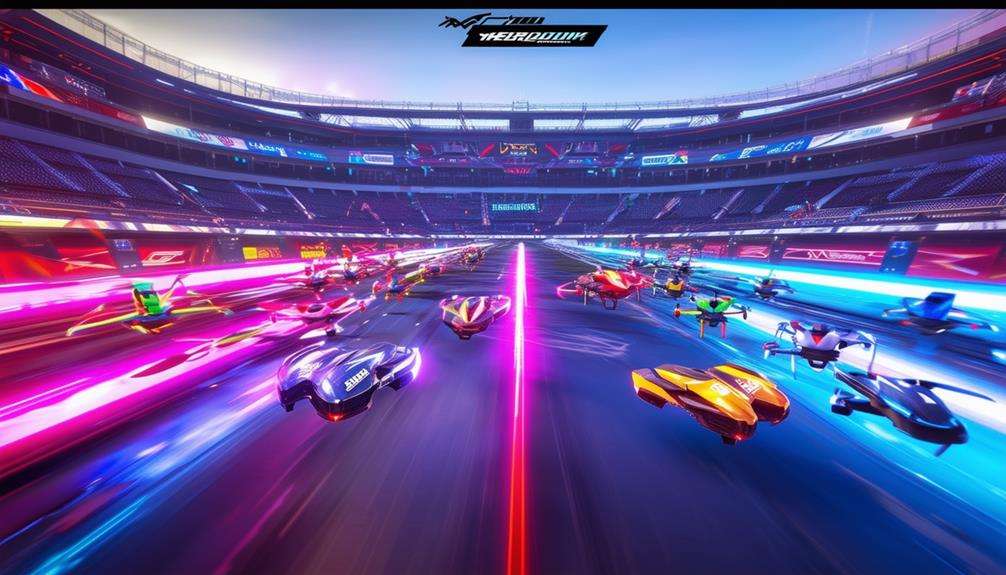
Following our exploration of popular drone racing events, let's delve into the key players and teams that dominate this high-speed sport.
In the competitive landscape of drone racing, several standout pilots and teams have emerged as leaders, showcasing exceptional skills and precision flying. Notable pilots such as Luke Bannister (BanniUK) and MinChan Kim (MinChan FPV) have gained international recognition for their agility and control, often leaving spectators in awe. These pilots, along with their respective teams, continuously push the boundaries of what's possible in drone racing.
Here are some of the top teams that have made significant impacts:
- XBlades Racing: Known for their consistent performance in the Drone Racing League (DRL).
- Quad Force One: Another top contender in the DRL, showcasing immense talent.
- Team BlackSheep: Famous for their inventive approach and strong presence in international competitions.
- Team BigWhoop: Renowned for their skillful pilots and competitive edge.
- Apex Racing and Luminary Racing: Both teams bring a diverse range of talents to the global stage.
These teams and pilots are the backbone of the sport, driving creativity and excitement in every race. The competitive landscape of drone racing is more thrilling than ever, thanks to their relentless pursuit of excellence.
Drone Racing Courses
Drone racing courses feature intricate design elements that make each race unique. Safety protocols and regulations ensure the protection of pilots and spectators, while technological innovations continually push the boundaries of what's achievable. These factors together create a dynamic and thrilling environment for both competitors and fans.
Course Design Elements
Designing drone racing courses involves creating intricate layouts with tight turns, challenging obstacles, and varying elevations to test pilots' skills and precision. Effective course design must take into account various elements to make the race both exciting and demanding. Obstacles such as gates, ladders, and hurdles are strategically placed to push pilots to their limits, requiring agile maneuvers and quick reflexes.
In first-person view (FPV) racing, pilots navigate solely by the camera feed from their drones, making these elements even more critical. Here's an overview of key elements in a top-tier drone racing course:
- Tight turns and hairpin bends: Sharp angles requiring precise control and quick thinking.
- Vertical ascents and descents: Changes in elevation testing a pilot's ability to manage speed and pitch.
- Gates: Narrow passages demanding accuracy to avoid penalties or crashes.
- Ladders and hurdles: Sequential challenges that force pilots to maintain consistent performance under pressure.
- Virtual elements: In esports drone racing, digital courses can integrate real and virtual obstacles, enhancing the challenge.
This combination of features ensures a dynamic and competitive environment for drone racing.
Safety and Regulations
While intricate course designs make drone racing exhilarating, ensuring safety and adhering to regulations is vital for both pilots and spectators. Courses often feature varied obstacles such as gates, ladders, and hurdles at different elevations to challenge pilots' skills. However, with such complexity, safety regulations are essential to prevent accidents and injuries. These rules advise against exceeding speed limits and ensure that drones meet specific safety standards.
Esports drone racing also demands rigorous safety protocols, even in virtual environments. Though the risks differ, maintaining a controlled and fair racing experience remains paramount. Organizations such as the Drone Racing League (DRL) set the benchmark for safety in both physical and virtual settings. Virtual tracks, like the Biosphere SIM, provide challenging yet safe environments for pilots to hone their skills without physical risks.
Competitions held in stadiums globally attract numerous spectators, making adherence to safety regulations even more critical. Barriers and designated safe zones protect the audience, while clear guidelines ensure that pilots operate their drones responsibly. Ultimately, these measures make drone racing courses thrilling yet secure for everyone involved.
Technological Innovations
Technological innovations are revolutionizing drone racing courses, bringing unprecedented excitement and challenges for pilots. With advancements in drone technology, courses now push the limits of agility and precision, featuring intricate 3D layouts with gates, ladders, and hurdles at varying elevations. Pilots navigate these complex courses using FPV goggles, providing a real-time, immersive experience.
Drone racing has also expanded into the digital realm with virtual courses, merging the worlds of esports and physical racing. Platforms like the Drone Racing League (DRL) showcase tracks such as the Biosphere SIM, which offer unique and challenging environments designed to test skill and reflexes. These digital environments ensure every race is a thrilling experience.
Key features include:
- Intricate 3D layouts with gates and ladders
- Virtual courses that blend esports with physical racing
- Challenging tracks like the Biosphere SIM
- Worldwide stadium events that attract large audiences
- Obstacles crafted to test skills, agility, and precision
Whether racing in a stadium or a virtual arena, advancements in drone technology and course design keep the sport dynamic and exhilarating. The next time you put on your FPV goggles, prepare for an adrenaline-pumping adventure through meticulously crafted courses.
Skills and Strategies
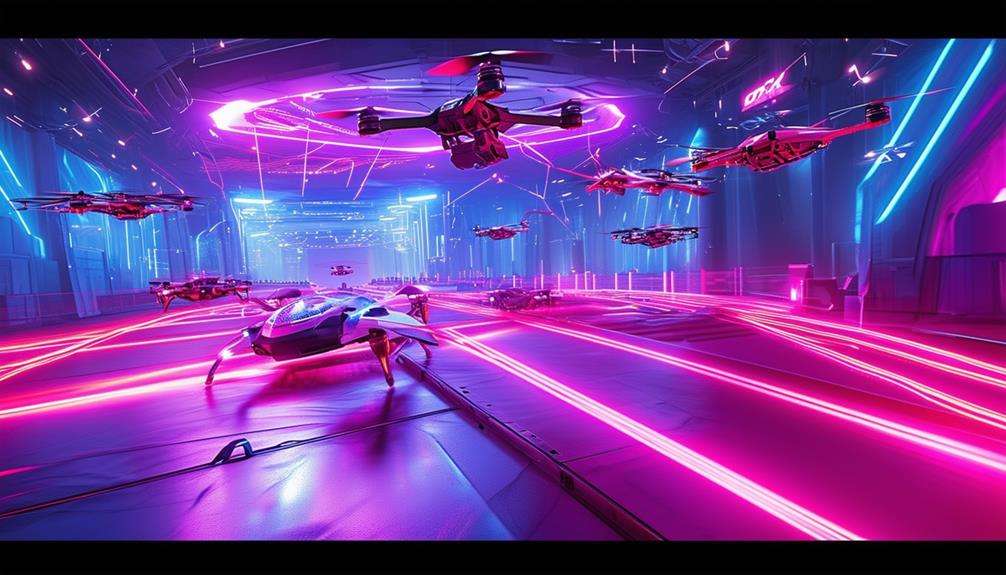
To excel in drone racing, you must master precision and control to navigate tight turns and obstacles flawlessly. Equally important are speed and agility, which allow you to outpace competitors while maintaining stability. Balancing these skills gives you a competitive edge on the racecourse.
Precision and Control
In drone racing, pilots must demonstrate exceptional precision and control to navigate intricate courses at high speeds. Utilizing first-person view (FPV) technology, you can immerse yourself directly into the cockpit of your drone, making precision and control paramount. Every split-second decision, each slight hand movement, and every millisecond count in this high-stakes sport.
To excel, you need:
- Steady hands: Crucial for maintaining control and executing smooth, accurate movements.
- Exceptional hand-eye coordination: Essential for maneuvering through tight turns and avoiding obstacles.
- Strategic planning: Necessary for anticipating challenges and plotting your course.
- Spatial awareness: Important for understanding the drone's position relative to obstacles and other drones.
- Technical skill: Required for mastering the controls and optimizing drone performance.
Precision and control aren't just about keeping your drone airborne; they involve balancing aggressive maneuvers with stability. With FPV, you're directly in the action, making your ability to execute precise controls even more critical. This combination of skills sets top pilots apart in the competitive world of drone racing.
Speed and Agility
Mastering speed and agility in drone racing requires quick reflexes and strategic thinking to navigate complex courses and outmaneuver competitors. As a drone racer, you must control your racing drone with precision while maintaining high speeds. The intricate courses often feature tight turns and numerous obstacles, necessitating split-second decisions.
Using a first-person view (FPV) headset, you experience the race from your drone's perspective, enhancing your ability to maneuver through challenging racecourses. This immersive experience allows you to anticipate obstacles and plan your moves effectively. The combination of FPV technology and your reflexes is crucial for maintaining speed without sacrificing control.
Successful drone racers employ various strategic maneuvers to gain an edge. Quick reflexes enable real-time course adjustments, while strategic thinking helps you plot the most efficient path. It's not just about flying fast; it's about flying smart. Agility is essential for making sharp turns or sudden changes in altitude, showcasing your finesse and control.
In drone racing competitions, the ability to blend speed with agility sets you apart. Each race demonstrates the skillful control and strategic mastery that top pilots bring to the sport.
Equipment and Gear
When delving into drone racing, high-quality equipment and gear are essential for peak performance and an exhilarating experience. At the core of competitive racing are racing drones, designed for speed, agility, and precise control.
Here's a quick rundown of the necessary gear:
- Racing Drones: Built for speed, agility, and durability, these drones often feature lightweight frames and powerful motors.
- FPV Goggles: These provide a first-person view, immersing you in the race by displaying live video feed from your drone.
- Radio Transmitters: Essential for precise control of your drone, these devices are vital for fast-paced racing scenarios.
- High-Performance Batteries: Ensure your drone has the power to sustain high speeds and quick maneuvers.
- Customization Tools: Many pilots customize their drones, tweaking components for top-notch performance tailored to their racing style.
Using the right gear is fundamental for an immersive experience, enhancing the thrill for both pilots and spectators.
Getting Started in Drone Racing
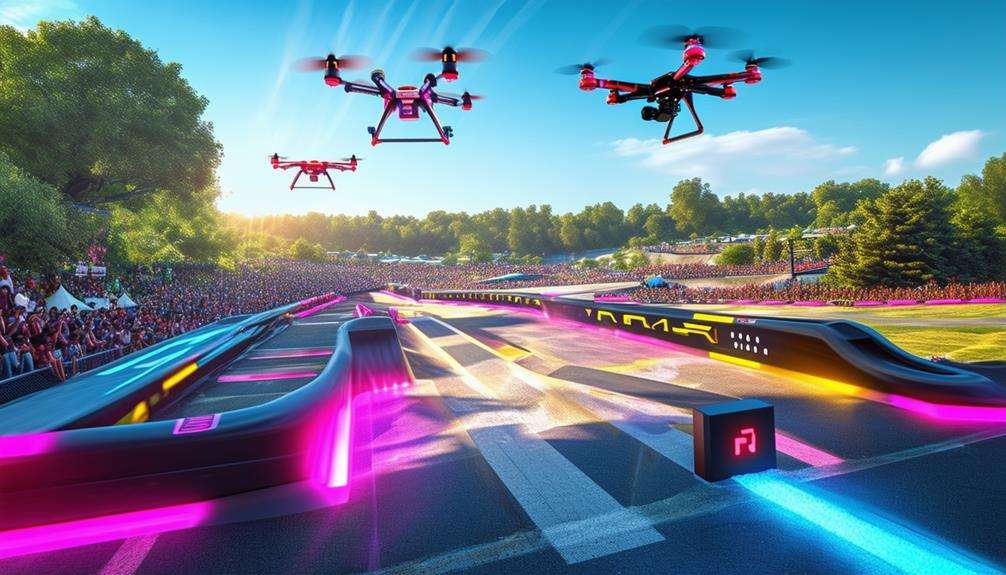
Diving into drone racing is an exhilarating experience that combines cutting-edge technology with high-speed competition. To get started in the sport of drone racing, you'll need a solid understanding of drones and the essential gear required. Begin by selecting a racing drone that fits your skill level. Many beginners start with ready-to-fly kits, which include everything you need to get airborne quickly.
A critical component of drone racing is the first-person view (FPV) system. This setup includes FPV goggles, allowing you to see from the drone's perspective, making the experience more immersive and exciting. You'll feel like you're in the cockpit, maneuvering through obstacles and racing against competitors.
Next, familiarize yourself with the different competition modes in drone racing. From events like the World Drone Grand Prix to the World Drone Championship, there are numerous opportunities to test your skills. For younger enthusiasts, National Youth Drone Competitions emphasize STEAM education, making it a fantastic entry point.
Future of Drone Racing
Looking ahead, the future of drone racing is set to be shaped by technological innovations that will enhance the excitement of competitions. With increasing sponsorship and prize money, the sport is poised to attract a larger international audience. These advancements promise to make drone racing more dynamic, accessible, and engaging for fans and participants alike.
Technological Advancements Impacting Competitions
Technological advancements are revolutionizing drone racing, making it faster, safer, and more thrilling than ever before. The introduction of first-person view (FPV) systems allows pilots to experience drone flying as if they're in the cockpit, enhancing both the adrenaline rush and precision control.
These innovations are transforming the sport:
- Faster and more agile drones: Cutting-edge motors and lightweight materials enable drones to zip through complex courses with lightning speed.
- Enhanced safety features: Improved obstacle detection and collision avoidance systems maintain safety without compromising speed.
- Augmented reality (AR) challenges: AR overlays virtual obstacles and checkpoints, adding new dimensions to races without physical constraints.
- Team-based races: Innovations in communication technology facilitate synchronized team maneuvers, adding strategy and excitement.
- Professional-grade equipment: High-quality cameras, reliable transmitters, and durable frames ensure a professional racing experience.
As technology evolves, drone racing is poised to become a mainstream professional sport. Sponsorships, prize money, and a growing fan base reflect the sport's bright future. With these advancements, drone racing isn't just a hobby; it's becoming a serious, competitive sport that's here to stay.
Expanding Global Audience Reach
How is drone racing captivating a global audience and securing its place as a mainstream sport? The Drone Racing League (DRL) has significantly expanded its broadcast reach, now airing live races on 13 sports networks across six continents. This strategic expansion enables the sport to reach over 140 markets and more than 250 million households. Notably, countries like the UK, Brazil, Australia, and China have experienced substantial viewership growth, with China's audience tripling.
Domestically, DRL has increased its presence on NBC, ensuring more consistent coverage. Additionally, they've leveraged social media platforms, particularly TikTok, to engage a younger, tech-savvy audience. Partnerships with major companies such as T-Mobile and DraftKings further enhance their visibility and credibility.
Collaborating with tech and entertainment giants like Algorand, Draganfly, and the US Air Force, DRL showcases its innovative edge. These partnerships not only attract a broader audience but also complement traditional sports leagues. Social media is integral to this strategy, offering highlights, behind-the-scenes footage, and interactive content.
Sponsorship and Prize Growth
Drone racing's transformation into a professional sport is significantly driven by the rise in sponsorships and prize money. As technology advances, more sponsors recognize the sport's growing market value and popularity, leading to increased investment. This surge in sponsorship not only boosts prize pools but also enhances the sport's status and competitiveness.
Key factors shaping the future of drone racing include:
- Increased Sponsorship: Major tech and drone companies are heavily investing, recognizing the potential in this high-adrenaline, tech-driven sport.
- Growing Prize Money: Enhanced sponsorship deals lead to expanding prize pools, making drone racing a more lucrative career option for pilots.
- Technological Innovation: Cutting-edge technology attracts sponsors and improves the viewing experience, further legitimizing the sport.
- Mainstream Acceptance: As drone racing gains mainstream attention, more brands are eager to associate with the sport.
- Market Value: The sport's increasing market value reflects its growing fan base and commercial appeal.
As drone racing continues to grow, pilots can expect more lucrative opportunities. Sponsorship and prize money will keep increasing, pushing the sport further into the spotlight and solidifying its place in the professional sports world.
Conclusion
Drone racing has evolved from grassroots beginnings into a global phenomenon. With cutting-edge technology, high-stakes competitions, and skilled pilots, the sport's future is promising. If you're passionate about speed, agility, and innovation, drone racing offers an electrifying experience. Immerse yourself, master the skills, and join this rapidly growing, adrenaline-fueled community. The sky's the limit!

